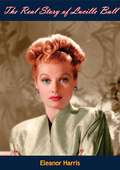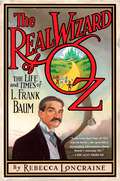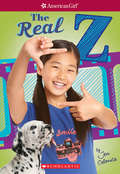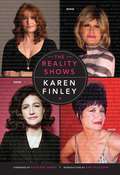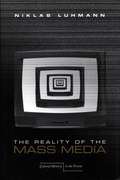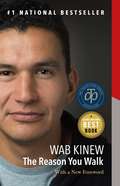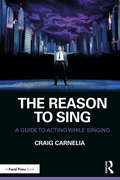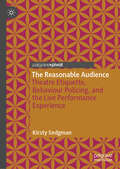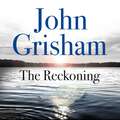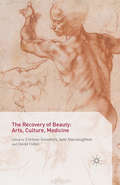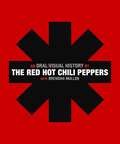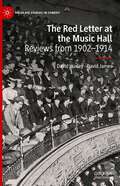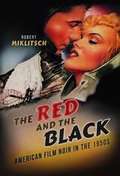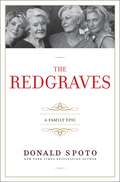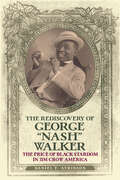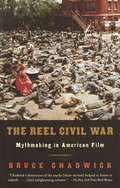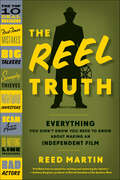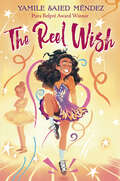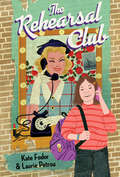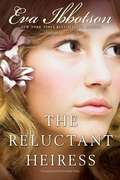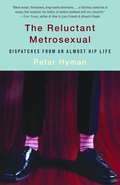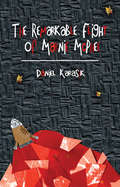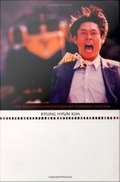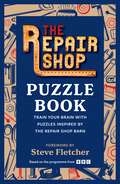- Table View
- List View
The Real Story of Lucille Ball
by Eleanor HarrisThe difficult early years…The truth about her and Desi…What’s behind I Love Lucy…First published in 1954, this is the full story of the actress who struggled to achieve stardom in the savagely competitive world of Hollywood and then went on to top place in television. And the story of the woman who won the harder battle of preserving the things she loved—marriage, home, and family—against the unceasing demands of success.
The Real Wizard of Oz: The Life and Times of L. Frank Baum
by Rebecca LoncraineIn the first major literary biography of L. Frank Baum, Rebecca Loncraine tells the story of Oz as you've never heard it, with a look behind the curtain at the vivid life and eccentric imagination of its creator.L. Frank Baum wrote The Wonderful Wizard of Oz in 1899 and it was first published in 1900. A runaway hit, it was soon recognized as America's first modern fairy tale. Baum's life story, like the fictional world he created, is uniquely American, rooted in the transforming historical changes of his times. Baum was a complex and eccentric man who could never stay put for long; his restless creative spirit and voracious appetite for new projects led him across the U.S. during his lifetime, and he drew energy and inspiration from each new dramatic landscape he encountered,. Born in 1856, Baum spent his youth in the Finger Lakes region of New York as amputee soldiers returned from the Civil War; childhood mortality was also commonplace, blurring the lines between the living and the dead, and making room in Baum's young imagination for vividly real ghosts. When Baum was growing up, P. T. Barnum ruled the minds of small towns and his traveling circus was the most famous act around. Baum married a headstrong young woman named Maud Gage and they ventured out west to Dakota Territory, where they faced violent tornadoes, Ghost Dancing tribes and desperate droughts, before trading the hardships on the Great Plains for the excitement of Chicago and the fantastical White City of the World's Fair.Baum's writing tapped into an inner world that blurred his own sense of reality and fantasy. The Land of Oz, which Baum believed he had "discovered" rather than invented, grew into something far bigger and more popular than he'd ever imagined. After the roaring success of The Wonderful Wizard of Oz in 1900, he became a kind of slave to his creation, trapped inside Oz as his army of demanding child fans kept sending him back there to create new adventures for Dorothy, Toto and the humbug wizard. He went on to write thirteen sequels to his first Oz book. He also wrote the first Broadway adaptations of his Oz tales, and turned his Oz books into some of the first motion pictures in a small and undiscovered rural settlement called "Hollywood". Baum co-founded the Oz Film Manufacturing Company, even as critics warned that no one would pay to see a children's story. And they were right- his early ventures were box office flops and the world was not ready for Oz on screen until 1939, when MGM released "The Wizard of Oz" in brilliant Technicolor. Baum was not around to see it-he'd died in bed in 1919 just weeks after completing his final Oz book. But the book and film alike have become classics, just as well-loved today as they were when they first appeared.The Real Wizard of Oz is an imaginatively written work that stretches the genre of biography and enriches our understanding of modern fairytales. L. Frank Baum, author of The Wonderful Wizard of Oz and its thirteen sequels, lived during eventful times in American history-- from 1856 to 1919-- that influenced nearly every aspect of his writing, from the Civil War to Hollywood, which was emerging as a modern Emerald City full of broken dreams and humbug wizards, to the gulf between America's prairie heartland, with its wild tornadoes, and its cities teeming with "Tin Man" factory workers. This is a colorful portrait of one man's vivid and eccentric imagination and the world that shaped it. Baum's famous fairytale is filled with the pain of the economic uncertainties of the Gilded Age and with a yearning for real change, ideas which many contemporary Americans will recognize. The Wizard of Oz continues to fascinate and influence us because it explores universal themes of longing for a better world, homesickness and finding inner strength amid the storms.
The Real Z: Z Yang, Book 1) (American Girl: Z Yang #1)
by Jen CalonitaAnd action! Z knows what she's doing when it comes to making movies. She's an expert at stop-motion video. In this first book about the aspiring filmmaker, Z has to make a whole new kind of movie--a documentary--and it's harder than she thought. Z wants to wow the judges, but she's not sure her ideas are good enough for a film festival. With the help of her friends, Z shoots a lot of footage, but something about it doesn't feel right. Should she start over? As she tries to make a movie she can be proud of, Z discovers that to be a real filmmaker, she'll first have to be her real self.
The Reality Shows
by Ann Pellegrini Karen Finley Kathleen Hanna"Ms. Finley hasn't lost the power to disturb."-Ben Brantley, The New York TimesNo other contemporary performing artist has captured the psychological complexity of this decade's political and social milestones as Karen Finley has in the past ten years. In her inimitable style, Finley has embodied some of the most troubling figures to cast a long shadow on the public imagination, and has envisioned a kind of catharsis within each drama: Liza Minnelli responds to the September 11 attacks; Terri Schaivo explains why Americans love a woman in a coma; Martha Stewart dumps George W. Bush during their tryst on the eve of the Republican National Convention; Silda Spitzer tells the former governor why "I'm sorry" just isn't enough; Jackie O cries, "Please stop looking at me!"The Reality Shows is a revelation of a decade by one of our greatest interpreters of popular and political culture.Karen Finley's raw and transgressive performances have long provoked controversy and debate. She has appeared and exhibited her visual art, performances, and plays internationally. The author of many books, including A Different Kind Of Intimacy, George & Martha, and Shock Treatment, she is a professor at the Tisch School of Art and Public Policy at NYU.Kathleen Hanna, activist and writer, was the lead singer of the punk band Bikini Kill before fronting the dance-punk band Le Tigre. She released a solo album under the name Julie Ruin.
The Reality of the Mass Media (Cultural Memory in the Present)
by Niklas Luhmann Kathleen Cross<p>In The Reality of the Mass Media, Luhmann extends his theory of social systems—applied in his earlier works to the economy, the political system, art, religion, the sciences, and law—to an examination of the role of mass media in the construction of social reality. <p>Luhmann argues that the system of mass media is a set of recursive, self-referential programs of communication, whose functions are not determined by the external values of truthfulness, objectivity, or knowledge, nor by specific social interests or political directives. Rather, he contends that the system of mass media is regulated by the internal code information/noninformation, which enables the system to select its information (news) from its own environment and to communicate this information in accordance with its own reflexive criteria. <p>Despite its self-referential quality, Luhmann describes the mass media as one of the key cognitive systems of modern society, by means of which society constructs the illusion of its own reality. The reality of mass media, he argues, allows societies to process information without destabilizing social roles or overburdening social actors. It forms a broad reservoir (memory) of options for the future coordination of action, and it provides parameters for the stabilization of political reproduction of society, as it produces a continuous self-description of the world around which modern society can orient itself. <p>In his discussion of mass media, Luhmann elaborates a theory of communication in which communication is seen not as the act of a particular consciousness, nor the medium of integrative social norms, but merely the technical codes through which systemic operations arrange and perpetuate themselves.</p>
The Reason You Walk
by Wab KinewA moving story of father-son reconciliation told by a charismatic aboriginal starWhen his father was given a diagnosis of terminal cancer, Winnipeg broadcaster and musician Wab Kinew decided to spend a year reconnecting with the accomplished but distant aboriginal man who'd raised him. The Reason You Walk spans that 2012 year, chronicling painful moments in the past and celebrating renewed hopes and dreams for the future. As Kinew revisits his own childhood in Winnipeg and on a reserve in Northern Ontario, he learns more about his father's traumatic childhood at residential school. An intriguing doubleness marks The Reason You Walk, itself a reference to an Anishinaabe ceremonial song. Born to an Anishinaabe father and a non-native mother, he has a foot in both cultures. He is a Sundancer, an academic, a former rapper, a hereditary chief and an urban activist. His father, Tobasonakwut, was both a beloved traditional chief and a respected elected leader who engaged directly with Ottawa. Internally divided, his father embraced both traditional native religion and Catholicism, the religion that was inculcated into him at the residential school where he was physically and sexually abused. In a grand gesture of reconciliation, Kinew's father invited the Roman Catholic bishop of Winnipeg to a Sundance ceremony in which he adopted him as his brother. Kinew writes affectingly of his own struggles in his twenties to find the right path, eventually giving up a self-destructive lifestyle to passionately pursue music and martial arts. From his unique vantage point, he offers an inside view of what it means to be an educated aboriginal living in a country that is just beginning to wake up to its aboriginal history and living presence. Invoking hope, healing and forgiveness, The Reason You Walk is a poignant story of a towering but damaged father and his son as they embark on a journey to repair their family bond. By turns lighthearted and solemn, Kinew gives us an inspiring vision for family and cross-cultural reconciliation, and for a wider conversation about the future of aboriginal peoples.
The Reason to Sing: A Guide to Acting While Singing
by Craig CarneliaIn The Reason to Sing, renowned composer-lyricist and teacher Craig Carnelia provides musical actors with a step-by-step guide to making their singing performances more truthful, vivid, and full of life. Using a technique developed over decades of teaching the professional community of Broadway actors and students alike, The Reason to Sing utilizes detailed descriptions of sessions the author has had with his notable students and lays out a new and proven approach to help you build your skills, your confidence, and your career. This book is intended for musical theater acting students as well as working professionals and teachers of the craft.
The Reasonable Audience: Theatre Etiquette, Behaviour Policing, And The Live Performance Experience
by Kirsty SedgmanAudiences are not what they used to be. Munching crisps or snapping selfies, chatting loudly or charging phones onstage – bad behaviour in theatre is apparently on the rise. And lately some spectators have begun to fight back…The Reasonable Audience explores the recent trend of ‘theatre etiquette’: an audience-led crusade to bring ‘manners and respect’ back to the auditorium. This comes at a time when, around the world, arts institutions are working to balance the traditional pleasures of receptive quietness with the need to foster more inclusive experiences. Through investigating the rhetorics of morality underpinning both sides of the argument, this book examines how models of 'good' and 'bad' spectatorship are constructed and legitimised. Is theatre etiquette actually snobbish? Are audiences really more selfish? Who gets to decide what counts as ‘reasonable’ within public space?Using theatre etiquette to explore wider issues of social participation, cultural exclusion, and the politics of identity, Kirsty Sedgman asks what it means to police the behaviour of others.
The Reckoning: The Sunday Times Number One Bestseller
by John GrishamThe electrifying new thriller from internationally bestselling author John Grisham.John Grisham returns to Clanton, Mississippi, to tell the story of an unthinkable murder, the bizarre trial that followed it, and its profound and lasting effect on the people of Ford County.Pete Banning was Clanton's favourite son, a returning war hero, the patriarch of a prominent family, a farmer, father, neighbour, and a faithful member of the Methodist Church. Then one cool October morning in 1946. he rose early, drove into town, walked into the church, and calmly shot and killed the Reverend Dexter Bell.As if the murder wasn't shocking enough, it was even more baffling that Pete's only statement about it - to the sheriff, to his defense attorney, to the judge, to his family and friends, and to the people of Clanton - was 'I have nothing to say'.And so the murder of the esteemed Reverend Bell became the most mysterious and unforgettable crime Ford County had ever known.Praise for Grisham's latest book, The Rooster Bar'Scintillating storytelling' - The Sunday Times'A buoyant, mischievous thriller . . . This reliable best-selling author is feeling real pleasure, and not just obligation, in delivering his work' - New York Times(P)2018 Random House Audio
The Recovery of Beauty: Arts, Culture, Medicine
by David Fuller Corinne SaundersAn interdisciplinary collection of essays exploring the complex and conflicted topic of beauty in cultural, arts and medicine, looking back through the long cultural history of beauty, and asking whether it is possible to 'recover beauty'.
The Red Hot Chili Peppers: An Oral/Visual History
by The ChiliThe Red Hot Chili Peppers is the iconic band's audacious look back at their thirty-year odyssey—in their own words and accompanied by more than 300 spectacular photos and ephemera. Intimate, breathtaking, and outrageous, this is the essence of the Red Hot Chili Peppers."I am struck with the moments of these photos, the feelings of the times they were taken, and where we were at on our beautiful and happy-sad journey. It's pretty fucking heavy, actually, like thinking how much we have changed over the years, and all the different dynamics of our lives that shaped us, and also realizing so clearly that nothing has changed at all—we're all still just trying to get it on, make something great."It is all here, nothing can hide: all the honesty, the pretense, the courage and one-of-a-kind-ness, the unbridled joy, the melancholy, and the shields we put up to shelter our scared, vulnerable little selves."—Flea
The Red Letter at the Music Hall: Reviews from 1902–1914 (Palgrave Studies in Comedy)
by David James David HuxleyThis book reprints and analyses reviews of music hall acts from the family magazine The Red Letter, which was published by the Scottish based firm D C Thomson from 1899 to 1987. The articles under review range in date from 1902 to 1914, covering theatres all over Britain and acts from around the world. The reviews are uniquely detailed and shed light not only on the early acts of comics who would later go on to achieve wider fame, such as Will Hay and Robb Wilton, but also reveal the acts of long forgotten performers. These so-called ‘wines and spirits’ acts—acts that would never top the bill but who nevertheless toured the halls, sometimes for years on end, such as female impersonator Albert Letine, comedy magician Chris van Bern and female stand up Anna Dorothy amongst many others—deserve to be remembered every bit as much as the top of the bill acts. The articles are arranged in sections, covering race, gender, character comedy, physical comedy, male comedy and specialty or ‘spesh’ acts. The reviews reveal not only the contents of the acts but also the audience reactions to those acts and prevailing contemporary Edwardian attitudes. The articles are accompanied by their original illustrations, some of which are unique and, like the articles themselves, unseen for over a century.
The Red and the Black: American Film Noir in the 1950s
by Robert MiklitschCritical wisdom has it that we said a long goodbye to film noir in the 1950s. Robert Miklitsch begs to differ. Pursuing leads down the back streets and alleyways of cultural history, The Red and the Black proposes that the received rise-and-fall narrative about the genre radically undervalues the formal and thematic complexity of '50s noir and the dynamic segue it effected between the spectacular expressionism of '40s noir and early, modernist neo-noir. Mixing scholarship with a fan's devotion to the crooked roads of critique, Miklitsch autopsies marquee films like D.O.A., Niagara, and Kiss Me Deadly plus a number of lesser-known classics. Throughout, he addresses the social and technological factors that dealt deuce after deuce to the genre--its celebrated style threatened by new media and technologies such as TV and 3-D, color and widescreen, its born losers replaced like zombies by All-American heroes, the nation rocked by the red menace and nightmares of nuclear annihilation. But against all odds, the author argues, inventive filmmakers continued to make formally daring and socially compelling pictures that remain surprisingly, startlingly alive. Cutting-edge and entertaining, The Red and the Black reconsiders a lost period in the history of American movies.
The Red and the Blacklist: The Intimate Memoir of a Hollywood Expatriate
by Norma BarzmanThe horrors of the McCarthy era.
The Redgraves: A Family Epic
by Donald SpotoThe dramatic, poignant and revealing saga of the Redgraves, one of history's greatest families of actors. For more than a century, the Redgraves have defined theater and film while captivating the public eye. Their history is a rich tapestry of singularly talented individuals whose influence is felt to this day, yet their story has never before been told. In The Redgraves, bestselling biographer Donald Spoto draws on his close personal relationships with the family and includes both his interviews and unprecedented personal access to them. The result is a groundbreaking account of this extraordinary clan and their circle, including such luminaries as Elizabeth Taylor, Katharine Hepburn, and Sir Laurence Olivier. The story began in 1907 with the marriage of actress Daisy Scudamore to matinee idol Roy Redgrave and the birth in 1908 of their son, Michael, who became a famous stage actor and movie star. Michael's family and wild social circle knew that for decades he was insistently bisexual, notwithstanding his marriage to Rachel Kempson, one of England's most glamorous and admired actresses. Their daughter Vanessa, a great and revered performer, is the only British actress ever to win Oscar, Emmy, Tony, Cannes, Golden Globe, and Screen Actors Guild Awards--achievements that have been paralleled by a profound humanitarian commitment even as she tackled difficult and controversial roles. Vanessa's sister, Lynn Redgrave, led a triumphant and complex life in her own way, too. From her performance in the movie Georgy Girl to her prizewinning play about her father and her Oscar-nominated performance in Gods and Monsters, Lynn established herself as a very different Redgrave. Corin Redgrave, their brother, was known for his acclaimed performances onstage and screen--and he was a tireless and outspoken political radical. The family tradition of distinction continues with the careers of Joely Richardson and Jemma Redgrave and reached a high point in the life and career of Vanessa's daughter, Natasha Richardson, who earned a Tony Award for her role as Sally Bowles in the revival of Cabaret. Natasha's sudden death after a skiing lesson in 2009 shocked and saddened admirers of her work and graceful spirit. The product of more than thirty years of research, The Redgraves recounts the epic saga of a family that has extended the possibilities for actors on stage, screen, and television in Britain, America, and around the world.
The Rediscovery of George "Nash" Walker: The Price of Black Stardom in Jim Crow America
by Daniel E. AtkinsonThe first biography of George Walker, a uniquely Afro-American tale of innovation and triumph despite the odds; the story of an underdog with a bite!The Rediscovery of George "Nash" Walker is the first biography dedicated to the life and cultural contributions of this actor, writer, and producer who revolutionized Black American theatre during the early twentieth century. In 1892, Walker left his hometown with a medicine show and quickly formed a partnership with comedian Bert Williams that would last nearly eighteen years. Under the moniker of "The Two Real Coons," Williams and Walker used their comedy to erode the stereotyped White image of minstrel-style "cooning." Their theatrical company produced many popular plays, including Clorindy/A Lucky Coon (1899–1900), Policy Players (1900–1901), Sons of Ham (1901–1902), In Dahomey (1902–1905), Abyssinia (1905–1906), Bandanna Land (1907–1909), and Mr. Lode of Koal (1909–1910), even performing on Broadway and abroad. An activist at heart, Walker insisted that audiences receive carefully curated Black entertainment, told from a uniquely Afro-American perspective. Unfortunately, Walker contracted syphilis and was forced to retire in 1909, marking the end of the first golden age of Black theatre. Despite his landmark contributions, Walker's story has been largely forgotten. Drawing on archival resources, newspaper accounts, memoirs, oral histories, and manifestos written by Walker, this book celebrates the accomplishments of the vanguard generation of Black artists who were active between the close of the Civil War and the start of World War I.
The Reel Civil War: Mythmaking in American Film
by Bruce ChadwickArguing that film consistently distorts and sanitizes the past, Chadwick (history and film, Rutgers U.) details the distortions and myths purveyed by film from the KKK to the 1993 film in which actor Richard Gere plays a former slave-owner who is miraculously transformed into a populist who heroically drives off the KKK from a racially integrated community. For the bulk of film's history, myths have portrayed a myth of the underdog Southerner and demeaned African Americans, but new "politically correct," yet still sanitized, versions have begun to crop up in Hollywood productions. In the end, Chadwick seems to believe, despite changes in the treatment of the Civil war on screen, the "reel" still fails to be "real." Annotation c. Book News, Inc., Portland, OR (booknews.com)
The Reel Truth: Everything You Didn't Know You Need to Know About Making an Independent Film
by Reed MartinDid you know that most of the biggest indie filmmakers, screenwriters, and producers working today each made the same avoidable mistakes early on in their careers?The Reel Truth details the pitfalls, snares, and roadblocks that aspiring filmmakers encounter. Reed Martin interviewed more than one hundred luminaries from the independent film world to discuss the near misses that almost derailed their first and second films and identify the close shaves that could have cut their careers short. Other books may tell you the best way to make your independent film or online short, but no other book describes so candidly how to spot and avoid such issues and obstacles as equipment problems, shooting-day snafus, postproduction myths, theatrical distribution deal breakers, and dozens of other commonly made missteps, including the top fifty mistakes every filmmaker makes.From personal experience and his years as a freelance reporter covering independent film for USA Today and Filmmaker magazine, Martin uncovers the truth about the risks and potential rewards that go with chasing celluloid glory. Whether you're writing a screenplay, looking for financing, about to start shooting, or thinking about investing time and money (or someone else's money) in an independent film, The Reel Truth is a must-read.
The Reel Wish
by Yamile Saied MéndezAfter a panic attack prevents Florencia from performing as Clara in The Nutcracker and her best friend takes the lead, a new dance style helps her face her anxiety as well as a troubled friendship.Ballet is Florencia del Lago's entire world. After years of hard work, she is chosen as Clara in the winter production of The Nutcracker. Not only is she the youngest dancer to receive such an honor but also the first Latina. She's on track to be recruited by the best ballet companies.Unfortunately, she suffers a panic attack on opening night--on stage, in front of everyone. And then Selena, Florencia's best friend, steps right into the role to replace her. Just like that, Florencia's whole world falls apart--the ballet studio expels her, and her best friend turns on her, tormenting her on social media and in real life.But even though the one thing she was driven toward has come to an end, therapy and family support help Florencia open up to new experiences. She notices people at school she's never paid attention to before, and she even stumbles upon an Irish dance school and decides to give it a try. Can a new passion for Irish dance help Florencia find the joy of performing on the stage that she lost that fateful winter night?
The Rehearsal Club
by Kate Fodor Laurie PetrouA mystery spans decades at the Rehearsal Club in this story of sisterhood, friendship and following your dreams under marquee lights. Twelve-year-old Pal Gallagher is a newly minted New Yorker who loves to make people laugh and is hoping to find kindred spirits in her new city. Her older sister, Naomi, lives at the Rehearsal Club, a historic boarding house for aspiring actresses. Pal quickly gets swept up in the glamor and high-stakes of the theater world, and is drawn into a decades-old mystery about Posy, a boarder who was kicked out of the Club for reasons unknown. In 1954, Olive feels like she is working harder than anyone to make it to Broadway — along with the forty-four other young women who live at the Rehearsal Club. In comparison, her carefree friend Posy is making it look easy. Tensions rise when the two audition for the same part, kicking off a series of events that lead to Posy’s departure. What really happened all those years ago? The truth involves a Broadway play called The Weekend House, a necklace and a secret that Olive has kept all these years — until Pal and her new friends start digging into the past. What they learn could change the very fate of the Rehearsal Club itself. Key Text Features chapters dialogue author’s note Correlates to the Common Core States Standards in English Language Arts: CCSS.ELA-LITERACY.RL.5.3 Compare and contrast two or more characters, settings, or events in a story or drama, drawing on specific details in the text (e.g., how characters interact). CCSS.ELA-LITERACY.RL.6.3 Describe how a particular story's or drama's plot unfolds in a series of episodes as well as how the characters respond or change as the plot moves toward a resolution. CCSS.ELA-LITERACY.RL.6.6 Explain how an author develops the point of view of the narrator or speaker in a text.
The Reluctant Heiress
by Eva IbbotsonIn 1920s Austria, no one in the Viennese opera company knows that their wardrobe mistress Tessa is really a princess. But when the dashing self-made millionaire Guy Farne arrives at the opera, Tessa realizes that there may be more to life -- and love -- than just music.
The Reluctant Metrosexual
by Peter HymanThis collection of Peter Hyman's musings, more pop cultural than philosophical, range from the heartfelt to the absurd, whether he's describing the scotch-soaked grief of a bad breakup or his unfortunate decision to undergo a Brazilian bikini wax.
The Remarkable Flight of Marnie McPhee
by Daniel KarasikConvinced she is not like the rest of her boring family, nine-year-old Marnie McPhee decides it's time to leave Earth and take her place among the stars. But as she builds her spaceship, she realizes that maybe Earth isn't so bad after all, even if it is filled with imperfect human families. The Remarkable Flight of Marnie McPhee is a charming story of the infinite reaches of the imagination and the pleasure of dreaming.
The Remasculinization of Korean Cinema
by Kyung Hyun KimIn one of the first English-language studies of Korean cinema to date, Kyung Hyun Kim shows how the New Korean Cinema of the past quarter century has used the trope of masculinity to mirror the profound sociopolitical changes in the country. Since 1980, South Korea has transformed from an insular, authoritarian culture into a democratic and cosmopolitan society. The transition has fueled anxiety about male identity, and amid this tension, empowerment has been imagined as remasculinization. Kim argues that the brutality and violence ubiquitous in many Korean films is symptomatic of Korea's on-going quest for modernity and a post-authoritarian identity. Kim offers in-depth examinations of more than a dozen of the most representative films produced in Korea since 1980. In the process, he draws on the theories of Jacques Lacan, Slavoj Zizek, Gilles Deleuze, Rey Chow, and Kaja Silverman to follow the historical trajectory of screen representations of Korean men from self-loathing beings who desire to be controlled to subjects who are not only self-sufficient but also capable of destroying others. He discusses a range of movies from art-house films including To the Starry Island (1993) and The Day a Pig Fell into the Well (1996) to higher-grossing, popular films like Whale Hunting (1984) and Shiri (1999). He considers the work of several Korean auteurs--Park Kwang-su, Jang Sun-woo, and Hong Sang-su. Kim argues that Korean cinema must begin to imagine gender relations that defy the contradictions of sexual repression in order to move beyond such binary struggles as those between the traditional and the modern, or the traumatic and the post-traumatic.
The Repair Shop Puzzle Book: Train your brain with puzzles inspired by the Repair Shop barn
by The Repair ShopThe first puzzle book based on the BAFTA-award-winning television show The Repair Shop, with a foreword from The Repair Shop clocks expert Steve Fletcher.Think you know about the Repair Shop, its crafts, craftspeople and stories? Looking for fun brainteasers, word games and quizzes to train your brain and hone your problem solving skills? It's time to put your knowledge to the test with this collection of questions and puzzles designed to challenge and entertain.Blending together basic trivia, complex wordplay and a range of visual teasers, the book calls on the knowledge of Repair Shop fans to provide hours of challenges inspired by the iconic barn and the work that goes on inside. From silversmithing and woodworking, to teddy bears, clocks and paintings, the puzzles draw on the wide range of skills and objects that the Repair Shop team are famed for.With difficulty levels varying from pleasantly tricky to fiendishly hard, The Repair Shop Puzzle Book will delight all fans of the show.
